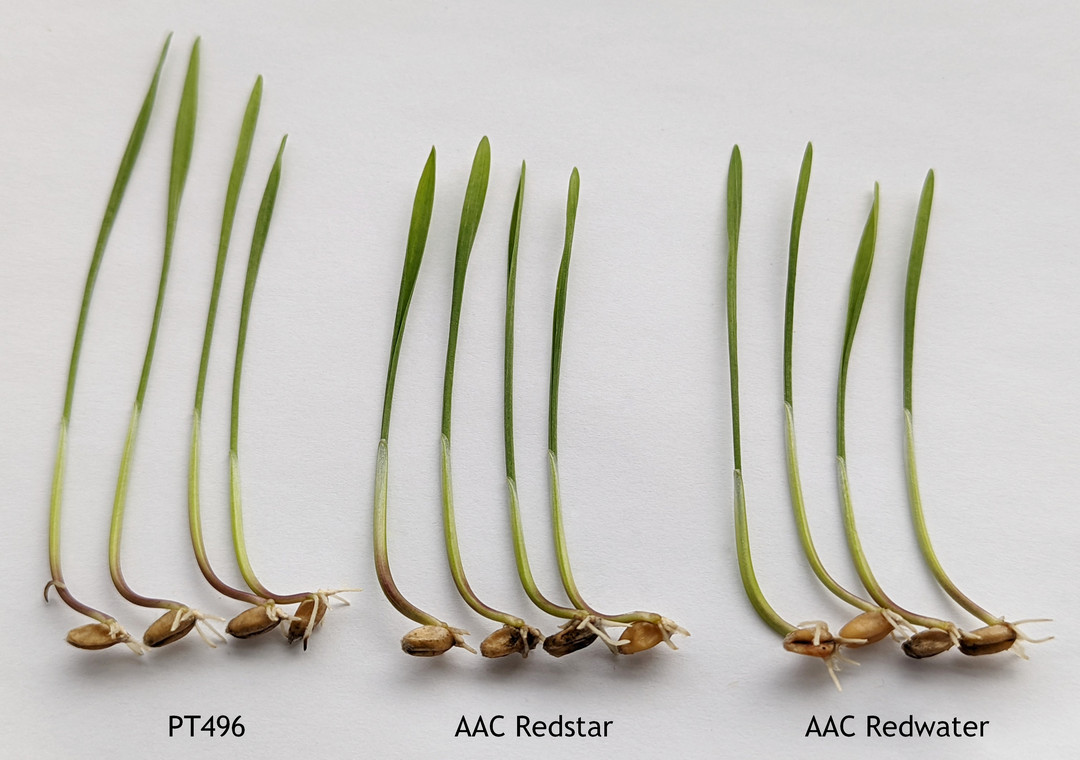AAC Hassler
| Denomination: | 'AAC Hassler' |
|---|---|
| Previously Proposed Denomination: | 'PT496' |
| Botanical Name: | Triticum aestivum |
| Applicant/Holder: |
Agriculture & Agri-Food Canada, Brandon Brandon Research Centre, 18th St. & Grand Valley R P.O. Box 1000A, R.R. #3 Brandon, Manitoba R7A 5Y3 Canada |
| Breeder: |
Santosh Kumar, Agriculture & Agri-Food Canada, Brandon, Manitoba |
| Agent in Canada: |
Agriculture & Agri-Food Canada Office of Intellectual Property and Commercialization c/o Shannon Whyte 107 Science Place Saskatoon, Saskatchewan S7N 0X2 Canada Tel: (204) 999-9887 |
| Application Date: | 2022-04-26 |
| Provisional Protection:: | 2022-04-26 |
| Application Number: | 22-10895 |
| Grant of Rights Date: | 2024-04-18 |
| Certificate Number: | 7086 |
| Grant of Rights Termination Date: | 2044-04-18 |
Variety Description
Varieties used for comparison: 'AAC Redstar', AAC Redwater' and 'AAC Darby'
Summary: The coleoptile of 'AAC Hassler' has a strong intensity of anthocyanin colouration whereas that of 'AAC Redwater' has a medium intensity of anthocyanin colouration. At booting, the flag leaf sheath of 'AAC Hassler' has strong glaucosity whereas that of 'AAC Darby' has a medium degree of glaucosity. The lower side of the flag leaf blade of 'AAC Hassler' has strong to very strong glaucosity whereas that of 'AAC Darby' has a medium to strong degree of glaucosity. The shoulder on the lower glume of 'AAC Hassler' is narrow whereas it is medium to broad for 'AAC Redstar' and 'AAC Redwater', and of a medium width for 'AAC Darby'. The beak on the lower glume of 'AAC Hassler' is very long whereas it is of a medium length for the reference varieties. The kernel cheek shape of 'AAC Hassler' is rounded whereas it is angular for the reference varieties.
Description:
PLANT: spring type, common wheat, semi-erect growth habit at 5 to 9 tiller stage
SEEDLING (4-LEAF STAGE): strong anthocyanin colouration of the coleoptile
FLAG LEAF: strong glaucosity of sheath at heading, strong to very strong glaucosity of lower side of leaf blade
CULM: strong glaucosity of neck at heading
STRAW (AT MATURITY): pith of medium thickness in cross-section
SPIKE: strong glaucosity at heading, tapering to parallel sided shape in profile, medium to dense, yellow at maturity
AWNS: equal to spike length
LOWER GLUME SHOULDER: narrow
LOWER GLUME BEAK: very long
KERNEL: hard red type, medium to dark red, rounded cheek shape
DISEASE REACTIONS: resistant to Leaf rust (Puccinia triticina), Stripe rust (Puccinia striiformis) and Stem rust (Puccinia graminis); moderately resistant to moderately susceptible to Fusarium head blight (Fusarium graminearum)
INSECT REACTION: susceptible to Orange Wheat Blossom Midge (Sitodiplosis mosellana)
Origin & Breeding History: 'AAC Hassler' (experimental designations PT496 and 12B10-BF3G) originated from the cross between 'CDC Titanium' and 'Thorsby' conducted at the Agriculture and Agri-Food Canada, Beaverlodge Research and Development Centre in Beaverlodge, Alberta in 2012. The F1 progeny was increased in the greenhouse at the Beaverlodge Research Station in 2012 and 10 F2 bulk plots were seeded with 25 heads harvested per plot. In the winter of 2013-2014, 126 selected F3 heads were grown as hill plots in Palmerston North, New Zealand, from which 104 were selected with 4 heads harvested per plot. Selection criteria included seed appearance, stem rust, leaf rust, and common bunt resistance, protein concentration, flour yield and baking quality. Line progressions occurred from 2015 to 2018 with an F11 line being designated as 12B10-BF3G. The line was tested in the Parkland Bread Wheat Registration trials as PT496 from 2019 to 2021. Breeder seed production commenced in 2021 at the Agriculture and Agri-Food Canada Seed Increase Unit, Indian Head, Saskatchewan.
Tests & Trials: The comparative trials for 'AAC Hassler' were conducted at the Saskatoon Research and Development Centre in Saskatoon, Saskatchewan in 2021 and 2022. There were 3 replicates per variety arranged in an RCB design. Plots were 2.98 square metres, and consisted of 5 rows, 3.35 metres in length, with a row spacing of 18 cm. The planting density was 264 plants per square metre resulting in approximately 3000 plants per variety per year. Disease and insect reaction ratings were obtained from the Prairie Grain Development Committee assessed from 2019 to 2021.
Click on image for larger view

Wheat: 'AAC Hassler' (left) with reference varieties 'AAC Redstar' (centre) and 'AAC Redwater' (right)
- Date modified: